Literature Review and Critique: Managing Resistance to Change - VU
VerifiedAdded on 2023/06/12
|10
|2657
|315
Literature Review
AI Summary
This document presents a literature review focusing on managing resistance to change within organizations, a critical aspect of change management. It begins by highlighting the increasing complexity of the modern business world and the necessity for organizations to adapt to rapidly changing internal and external environments. The review delves into the nature of resistance to change, identifying it as a common reaction to perceived threats associated with new initiatives. It explores factors contributing to resistance, such as fear of the unknown, lack of trust, and organizational culture. The importance of managing resistance is emphasized, noting its potential impact on workplace environment, productivity, job satisfaction, and future change initiatives. Effective strategies for managing resistance are discussed, including establishing effective communication, engaging employees in the change process, providing accurate information, and utilizing established change models. The review concludes by reiterating the inevitability of both workplace changes and resistance, underscoring the need for HR managers to adopt planned approaches for successful change implementation.

CHANGE MANAGEMENT –
713496
713496
Paraphrase This Document
Need a fresh take? Get an instant paraphrase of this document with our AI Paraphraser
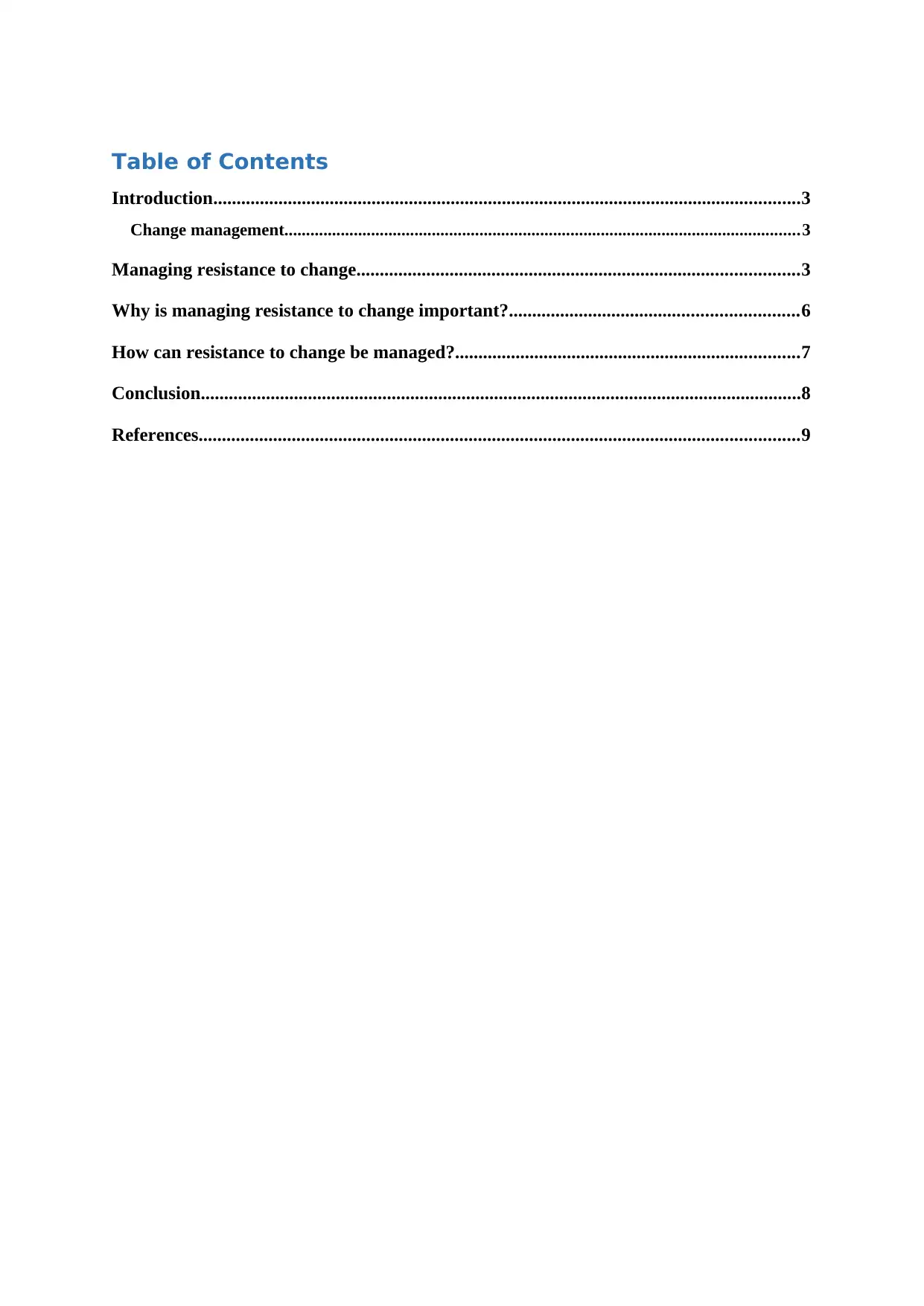
Table of Contents
Introduction..............................................................................................................................3
Change management.......................................................................................................................3
Managing resistance to change...............................................................................................3
Why is managing resistance to change important?..............................................................6
How can resistance to change be managed?..........................................................................7
Conclusion.................................................................................................................................8
References.................................................................................................................................9
Introduction..............................................................................................................................3
Change management.......................................................................................................................3
Managing resistance to change...............................................................................................3
Why is managing resistance to change important?..............................................................6
How can resistance to change be managed?..........................................................................7
Conclusion.................................................................................................................................8
References.................................................................................................................................9
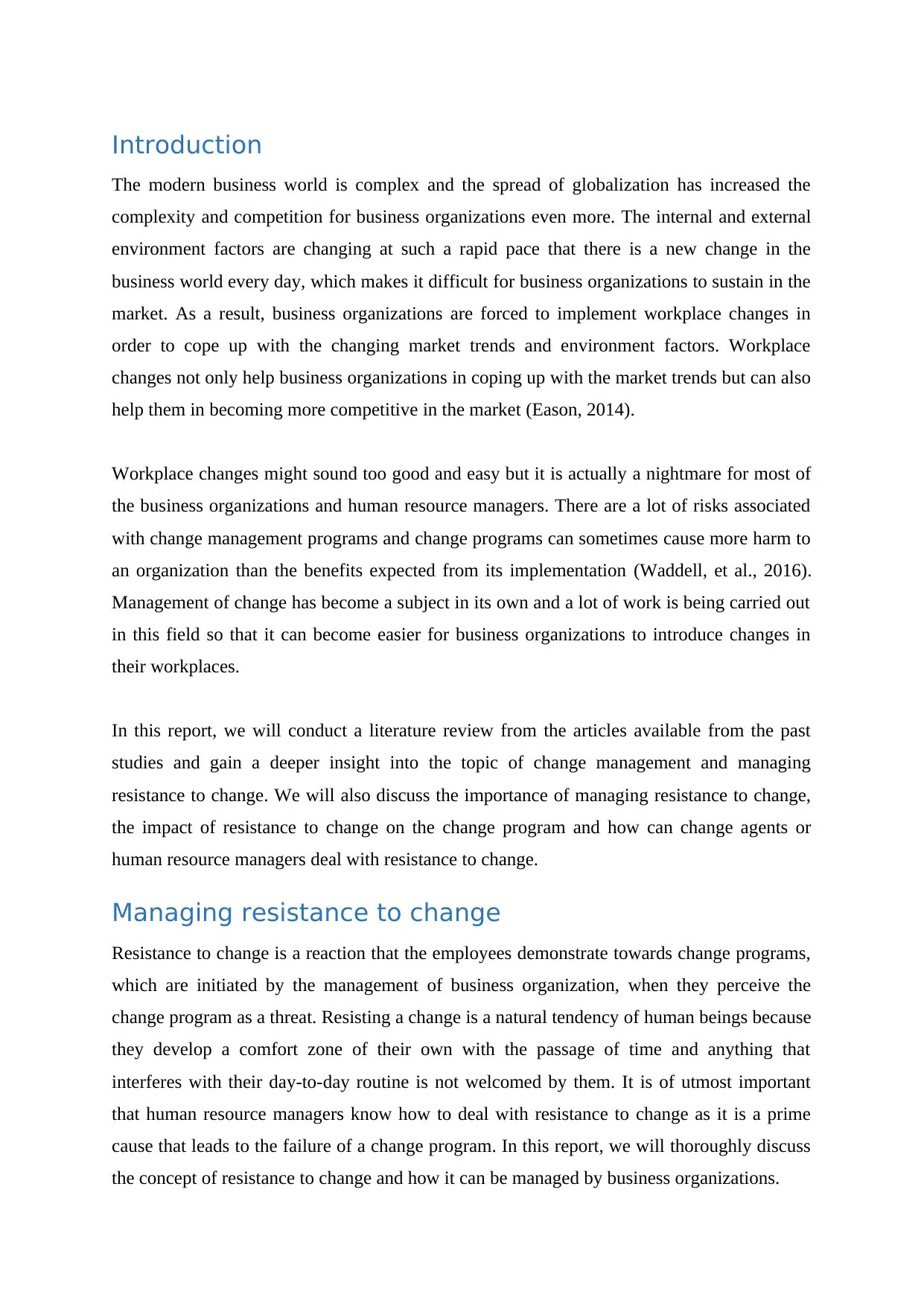
Introduction
The modern business world is complex and the spread of globalization has increased the
complexity and competition for business organizations even more. The internal and external
environment factors are changing at such a rapid pace that there is a new change in the
business world every day, which makes it difficult for business organizations to sustain in the
market. As a result, business organizations are forced to implement workplace changes in
order to cope up with the changing market trends and environment factors. Workplace
changes not only help business organizations in coping up with the market trends but can also
help them in becoming more competitive in the market (Eason, 2014).
Workplace changes might sound too good and easy but it is actually a nightmare for most of
the business organizations and human resource managers. There are a lot of risks associated
with change management programs and change programs can sometimes cause more harm to
an organization than the benefits expected from its implementation (Waddell, et al., 2016).
Management of change has become a subject in its own and a lot of work is being carried out
in this field so that it can become easier for business organizations to introduce changes in
their workplaces.
In this report, we will conduct a literature review from the articles available from the past
studies and gain a deeper insight into the topic of change management and managing
resistance to change. We will also discuss the importance of managing resistance to change,
the impact of resistance to change on the change program and how can change agents or
human resource managers deal with resistance to change.
Managing resistance to change
Resistance to change is a reaction that the employees demonstrate towards change programs,
which are initiated by the management of business organization, when they perceive the
change program as a threat. Resisting a change is a natural tendency of human beings because
they develop a comfort zone of their own with the passage of time and anything that
interferes with their day-to-day routine is not welcomed by them. It is of utmost important
that human resource managers know how to deal with resistance to change as it is a prime
cause that leads to the failure of a change program. In this report, we will thoroughly discuss
the concept of resistance to change and how it can be managed by business organizations.
The modern business world is complex and the spread of globalization has increased the
complexity and competition for business organizations even more. The internal and external
environment factors are changing at such a rapid pace that there is a new change in the
business world every day, which makes it difficult for business organizations to sustain in the
market. As a result, business organizations are forced to implement workplace changes in
order to cope up with the changing market trends and environment factors. Workplace
changes not only help business organizations in coping up with the market trends but can also
help them in becoming more competitive in the market (Eason, 2014).
Workplace changes might sound too good and easy but it is actually a nightmare for most of
the business organizations and human resource managers. There are a lot of risks associated
with change management programs and change programs can sometimes cause more harm to
an organization than the benefits expected from its implementation (Waddell, et al., 2016).
Management of change has become a subject in its own and a lot of work is being carried out
in this field so that it can become easier for business organizations to introduce changes in
their workplaces.
In this report, we will conduct a literature review from the articles available from the past
studies and gain a deeper insight into the topic of change management and managing
resistance to change. We will also discuss the importance of managing resistance to change,
the impact of resistance to change on the change program and how can change agents or
human resource managers deal with resistance to change.
Managing resistance to change
Resistance to change is a reaction that the employees demonstrate towards change programs,
which are initiated by the management of business organization, when they perceive the
change program as a threat. Resisting a change is a natural tendency of human beings because
they develop a comfort zone of their own with the passage of time and anything that
interferes with their day-to-day routine is not welcomed by them. It is of utmost important
that human resource managers know how to deal with resistance to change as it is a prime
cause that leads to the failure of a change program. In this report, we will thoroughly discuss
the concept of resistance to change and how it can be managed by business organizations.
⊘ This is a preview!⊘
Do you want full access?
Subscribe today to unlock all pages.

Trusted by 1+ million students worldwide
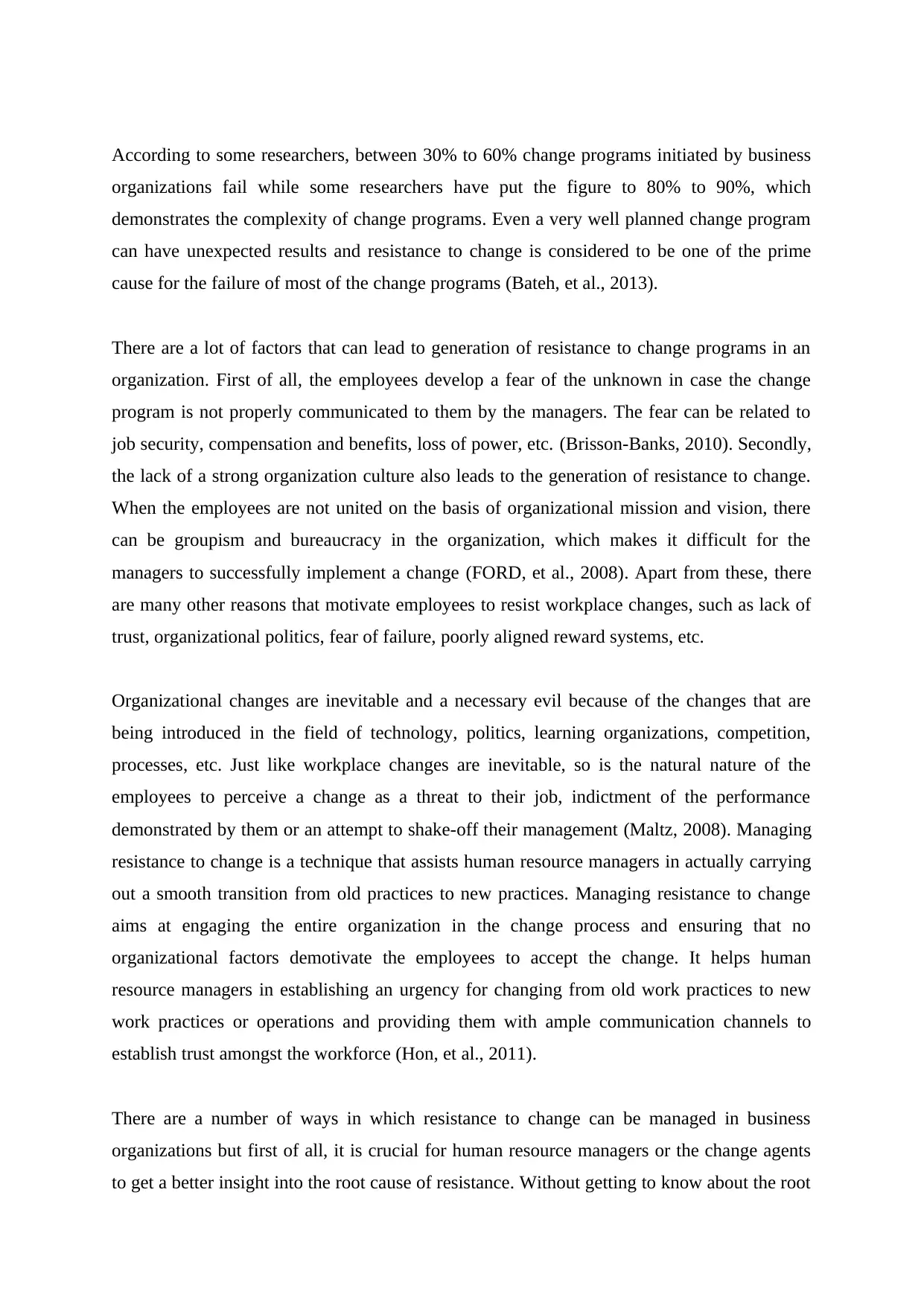
According to some researchers, between 30% to 60% change programs initiated by business
organizations fail while some researchers have put the figure to 80% to 90%, which
demonstrates the complexity of change programs. Even a very well planned change program
can have unexpected results and resistance to change is considered to be one of the prime
cause for the failure of most of the change programs (Bateh, et al., 2013).
There are a lot of factors that can lead to generation of resistance to change programs in an
organization. First of all, the employees develop a fear of the unknown in case the change
program is not properly communicated to them by the managers. The fear can be related to
job security, compensation and benefits, loss of power, etc. (Brisson‐Banks, 2010). Secondly,
the lack of a strong organization culture also leads to the generation of resistance to change.
When the employees are not united on the basis of organizational mission and vision, there
can be groupism and bureaucracy in the organization, which makes it difficult for the
managers to successfully implement a change (FORD, et al., 2008). Apart from these, there
are many other reasons that motivate employees to resist workplace changes, such as lack of
trust, organizational politics, fear of failure, poorly aligned reward systems, etc.
Organizational changes are inevitable and a necessary evil because of the changes that are
being introduced in the field of technology, politics, learning organizations, competition,
processes, etc. Just like workplace changes are inevitable, so is the natural nature of the
employees to perceive a change as a threat to their job, indictment of the performance
demonstrated by them or an attempt to shake-off their management (Maltz, 2008). Managing
resistance to change is a technique that assists human resource managers in actually carrying
out a smooth transition from old practices to new practices. Managing resistance to change
aims at engaging the entire organization in the change process and ensuring that no
organizational factors demotivate the employees to accept the change. It helps human
resource managers in establishing an urgency for changing from old work practices to new
work practices or operations and providing them with ample communication channels to
establish trust amongst the workforce (Hon, et al., 2011).
There are a number of ways in which resistance to change can be managed in business
organizations but first of all, it is crucial for human resource managers or the change agents
to get a better insight into the root cause of resistance. Without getting to know about the root
organizations fail while some researchers have put the figure to 80% to 90%, which
demonstrates the complexity of change programs. Even a very well planned change program
can have unexpected results and resistance to change is considered to be one of the prime
cause for the failure of most of the change programs (Bateh, et al., 2013).
There are a lot of factors that can lead to generation of resistance to change programs in an
organization. First of all, the employees develop a fear of the unknown in case the change
program is not properly communicated to them by the managers. The fear can be related to
job security, compensation and benefits, loss of power, etc. (Brisson‐Banks, 2010). Secondly,
the lack of a strong organization culture also leads to the generation of resistance to change.
When the employees are not united on the basis of organizational mission and vision, there
can be groupism and bureaucracy in the organization, which makes it difficult for the
managers to successfully implement a change (FORD, et al., 2008). Apart from these, there
are many other reasons that motivate employees to resist workplace changes, such as lack of
trust, organizational politics, fear of failure, poorly aligned reward systems, etc.
Organizational changes are inevitable and a necessary evil because of the changes that are
being introduced in the field of technology, politics, learning organizations, competition,
processes, etc. Just like workplace changes are inevitable, so is the natural nature of the
employees to perceive a change as a threat to their job, indictment of the performance
demonstrated by them or an attempt to shake-off their management (Maltz, 2008). Managing
resistance to change is a technique that assists human resource managers in actually carrying
out a smooth transition from old practices to new practices. Managing resistance to change
aims at engaging the entire organization in the change process and ensuring that no
organizational factors demotivate the employees to accept the change. It helps human
resource managers in establishing an urgency for changing from old work practices to new
work practices or operations and providing them with ample communication channels to
establish trust amongst the workforce (Hon, et al., 2011).
There are a number of ways in which resistance to change can be managed in business
organizations but first of all, it is crucial for human resource managers or the change agents
to get a better insight into the root cause of resistance. Without getting to know about the root
Paraphrase This Document
Need a fresh take? Get an instant paraphrase of this document with our AI Paraphraser
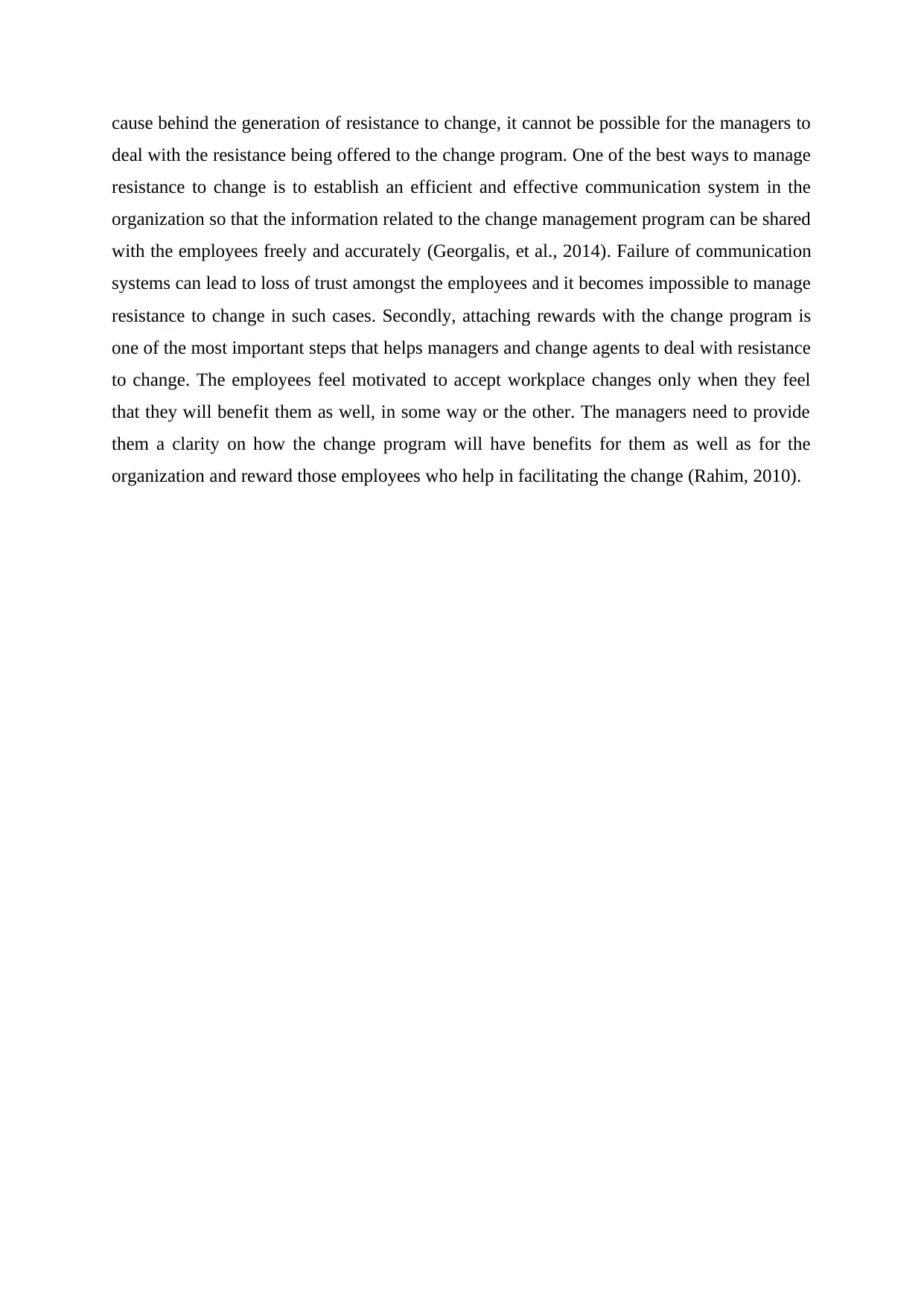
cause behind the generation of resistance to change, it cannot be possible for the managers to
deal with the resistance being offered to the change program. One of the best ways to manage
resistance to change is to establish an efficient and effective communication system in the
organization so that the information related to the change management program can be shared
with the employees freely and accurately (Georgalis, et al., 2014). Failure of communication
systems can lead to loss of trust amongst the employees and it becomes impossible to manage
resistance to change in such cases. Secondly, attaching rewards with the change program is
one of the most important steps that helps managers and change agents to deal with resistance
to change. The employees feel motivated to accept workplace changes only when they feel
that they will benefit them as well, in some way or the other. The managers need to provide
them a clarity on how the change program will have benefits for them as well as for the
organization and reward those employees who help in facilitating the change (Rahim, 2010).
deal with the resistance being offered to the change program. One of the best ways to manage
resistance to change is to establish an efficient and effective communication system in the
organization so that the information related to the change management program can be shared
with the employees freely and accurately (Georgalis, et al., 2014). Failure of communication
systems can lead to loss of trust amongst the employees and it becomes impossible to manage
resistance to change in such cases. Secondly, attaching rewards with the change program is
one of the most important steps that helps managers and change agents to deal with resistance
to change. The employees feel motivated to accept workplace changes only when they feel
that they will benefit them as well, in some way or the other. The managers need to provide
them a clarity on how the change program will have benefits for them as well as for the
organization and reward those employees who help in facilitating the change (Rahim, 2010).
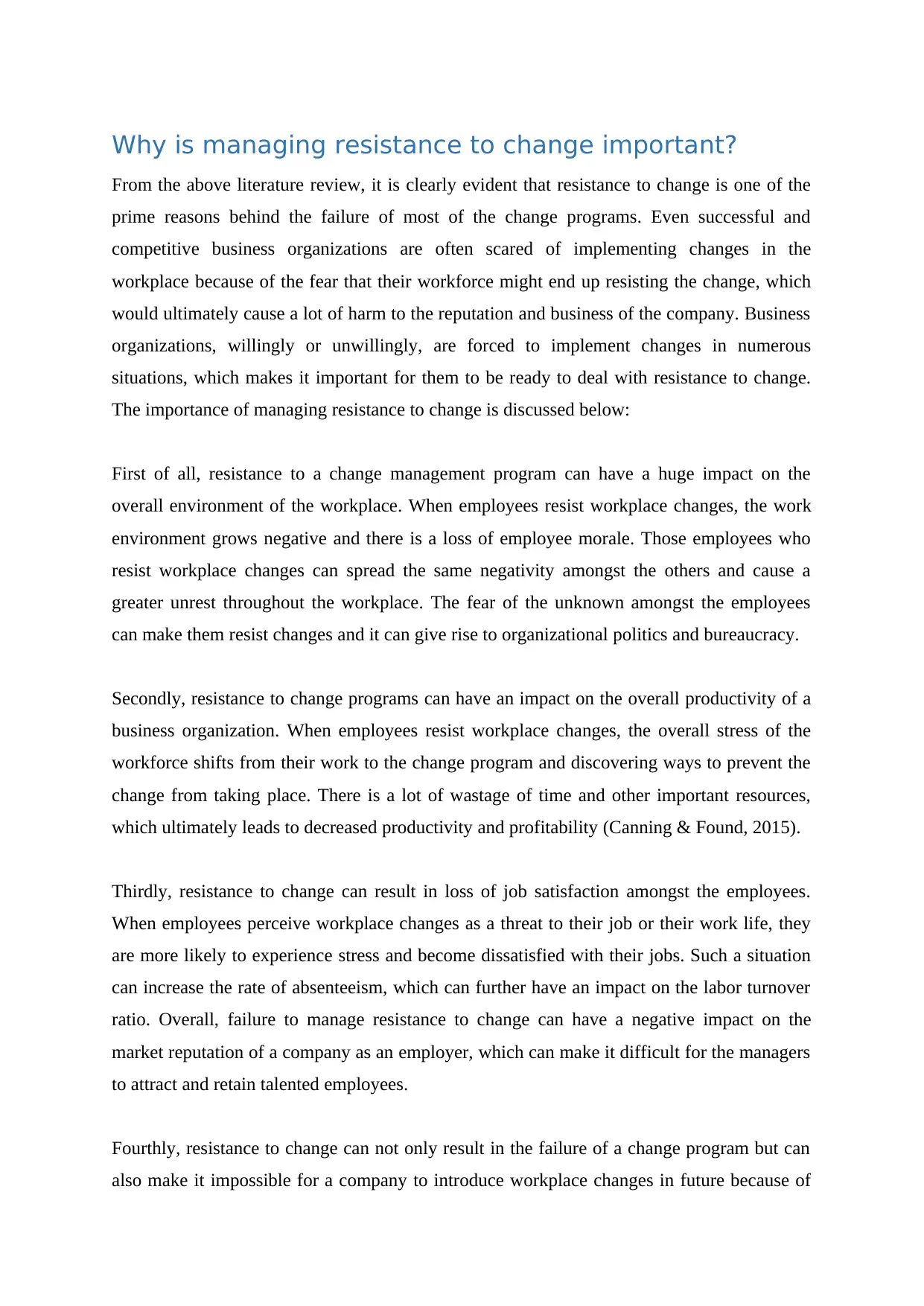
Why is managing resistance to change important?
From the above literature review, it is clearly evident that resistance to change is one of the
prime reasons behind the failure of most of the change programs. Even successful and
competitive business organizations are often scared of implementing changes in the
workplace because of the fear that their workforce might end up resisting the change, which
would ultimately cause a lot of harm to the reputation and business of the company. Business
organizations, willingly or unwillingly, are forced to implement changes in numerous
situations, which makes it important for them to be ready to deal with resistance to change.
The importance of managing resistance to change is discussed below:
First of all, resistance to a change management program can have a huge impact on the
overall environment of the workplace. When employees resist workplace changes, the work
environment grows negative and there is a loss of employee morale. Those employees who
resist workplace changes can spread the same negativity amongst the others and cause a
greater unrest throughout the workplace. The fear of the unknown amongst the employees
can make them resist changes and it can give rise to organizational politics and bureaucracy.
Secondly, resistance to change programs can have an impact on the overall productivity of a
business organization. When employees resist workplace changes, the overall stress of the
workforce shifts from their work to the change program and discovering ways to prevent the
change from taking place. There is a lot of wastage of time and other important resources,
which ultimately leads to decreased productivity and profitability (Canning & Found, 2015).
Thirdly, resistance to change can result in loss of job satisfaction amongst the employees.
When employees perceive workplace changes as a threat to their job or their work life, they
are more likely to experience stress and become dissatisfied with their jobs. Such a situation
can increase the rate of absenteeism, which can further have an impact on the labor turnover
ratio. Overall, failure to manage resistance to change can have a negative impact on the
market reputation of a company as an employer, which can make it difficult for the managers
to attract and retain talented employees.
Fourthly, resistance to change can not only result in the failure of a change program but can
also make it impossible for a company to introduce workplace changes in future because of
From the above literature review, it is clearly evident that resistance to change is one of the
prime reasons behind the failure of most of the change programs. Even successful and
competitive business organizations are often scared of implementing changes in the
workplace because of the fear that their workforce might end up resisting the change, which
would ultimately cause a lot of harm to the reputation and business of the company. Business
organizations, willingly or unwillingly, are forced to implement changes in numerous
situations, which makes it important for them to be ready to deal with resistance to change.
The importance of managing resistance to change is discussed below:
First of all, resistance to a change management program can have a huge impact on the
overall environment of the workplace. When employees resist workplace changes, the work
environment grows negative and there is a loss of employee morale. Those employees who
resist workplace changes can spread the same negativity amongst the others and cause a
greater unrest throughout the workplace. The fear of the unknown amongst the employees
can make them resist changes and it can give rise to organizational politics and bureaucracy.
Secondly, resistance to change programs can have an impact on the overall productivity of a
business organization. When employees resist workplace changes, the overall stress of the
workforce shifts from their work to the change program and discovering ways to prevent the
change from taking place. There is a lot of wastage of time and other important resources,
which ultimately leads to decreased productivity and profitability (Canning & Found, 2015).
Thirdly, resistance to change can result in loss of job satisfaction amongst the employees.
When employees perceive workplace changes as a threat to their job or their work life, they
are more likely to experience stress and become dissatisfied with their jobs. Such a situation
can increase the rate of absenteeism, which can further have an impact on the labor turnover
ratio. Overall, failure to manage resistance to change can have a negative impact on the
market reputation of a company as an employer, which can make it difficult for the managers
to attract and retain talented employees.
Fourthly, resistance to change can not only result in the failure of a change program but can
also make it impossible for a company to introduce workplace changes in future because of
⊘ This is a preview!⊘
Do you want full access?
Subscribe today to unlock all pages.

Trusted by 1+ million students worldwide
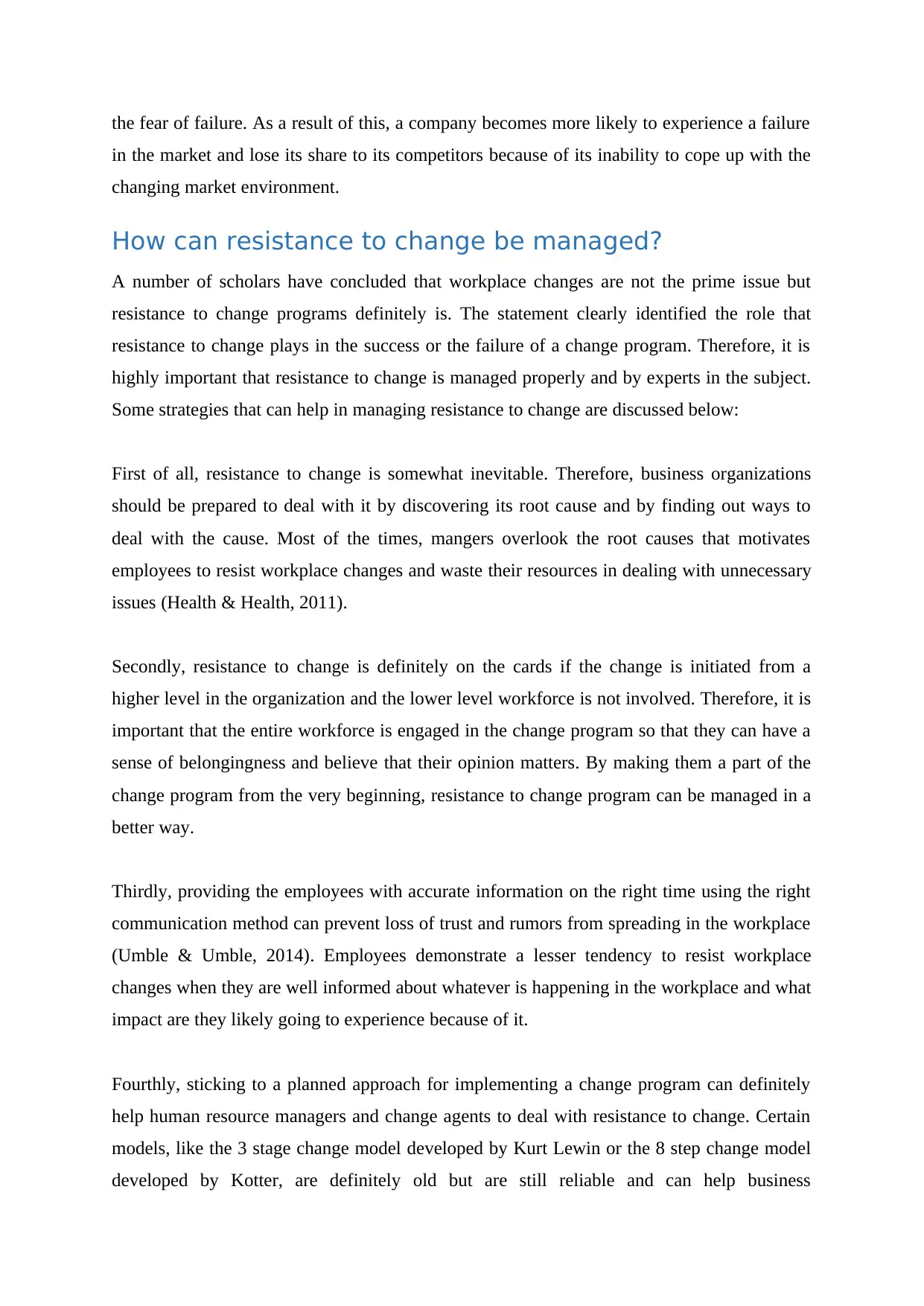
the fear of failure. As a result of this, a company becomes more likely to experience a failure
in the market and lose its share to its competitors because of its inability to cope up with the
changing market environment.
How can resistance to change be managed?
A number of scholars have concluded that workplace changes are not the prime issue but
resistance to change programs definitely is. The statement clearly identified the role that
resistance to change plays in the success or the failure of a change program. Therefore, it is
highly important that resistance to change is managed properly and by experts in the subject.
Some strategies that can help in managing resistance to change are discussed below:
First of all, resistance to change is somewhat inevitable. Therefore, business organizations
should be prepared to deal with it by discovering its root cause and by finding out ways to
deal with the cause. Most of the times, mangers overlook the root causes that motivates
employees to resist workplace changes and waste their resources in dealing with unnecessary
issues (Health & Health, 2011).
Secondly, resistance to change is definitely on the cards if the change is initiated from a
higher level in the organization and the lower level workforce is not involved. Therefore, it is
important that the entire workforce is engaged in the change program so that they can have a
sense of belongingness and believe that their opinion matters. By making them a part of the
change program from the very beginning, resistance to change program can be managed in a
better way.
Thirdly, providing the employees with accurate information on the right time using the right
communication method can prevent loss of trust and rumors from spreading in the workplace
(Umble & Umble, 2014). Employees demonstrate a lesser tendency to resist workplace
changes when they are well informed about whatever is happening in the workplace and what
impact are they likely going to experience because of it.
Fourthly, sticking to a planned approach for implementing a change program can definitely
help human resource managers and change agents to deal with resistance to change. Certain
models, like the 3 stage change model developed by Kurt Lewin or the 8 step change model
developed by Kotter, are definitely old but are still reliable and can help business
in the market and lose its share to its competitors because of its inability to cope up with the
changing market environment.
How can resistance to change be managed?
A number of scholars have concluded that workplace changes are not the prime issue but
resistance to change programs definitely is. The statement clearly identified the role that
resistance to change plays in the success or the failure of a change program. Therefore, it is
highly important that resistance to change is managed properly and by experts in the subject.
Some strategies that can help in managing resistance to change are discussed below:
First of all, resistance to change is somewhat inevitable. Therefore, business organizations
should be prepared to deal with it by discovering its root cause and by finding out ways to
deal with the cause. Most of the times, mangers overlook the root causes that motivates
employees to resist workplace changes and waste their resources in dealing with unnecessary
issues (Health & Health, 2011).
Secondly, resistance to change is definitely on the cards if the change is initiated from a
higher level in the organization and the lower level workforce is not involved. Therefore, it is
important that the entire workforce is engaged in the change program so that they can have a
sense of belongingness and believe that their opinion matters. By making them a part of the
change program from the very beginning, resistance to change program can be managed in a
better way.
Thirdly, providing the employees with accurate information on the right time using the right
communication method can prevent loss of trust and rumors from spreading in the workplace
(Umble & Umble, 2014). Employees demonstrate a lesser tendency to resist workplace
changes when they are well informed about whatever is happening in the workplace and what
impact are they likely going to experience because of it.
Fourthly, sticking to a planned approach for implementing a change program can definitely
help human resource managers and change agents to deal with resistance to change. Certain
models, like the 3 stage change model developed by Kurt Lewin or the 8 step change model
developed by Kotter, are definitely old but are still reliable and can help business
Paraphrase This Document
Need a fresh take? Get an instant paraphrase of this document with our AI Paraphraser
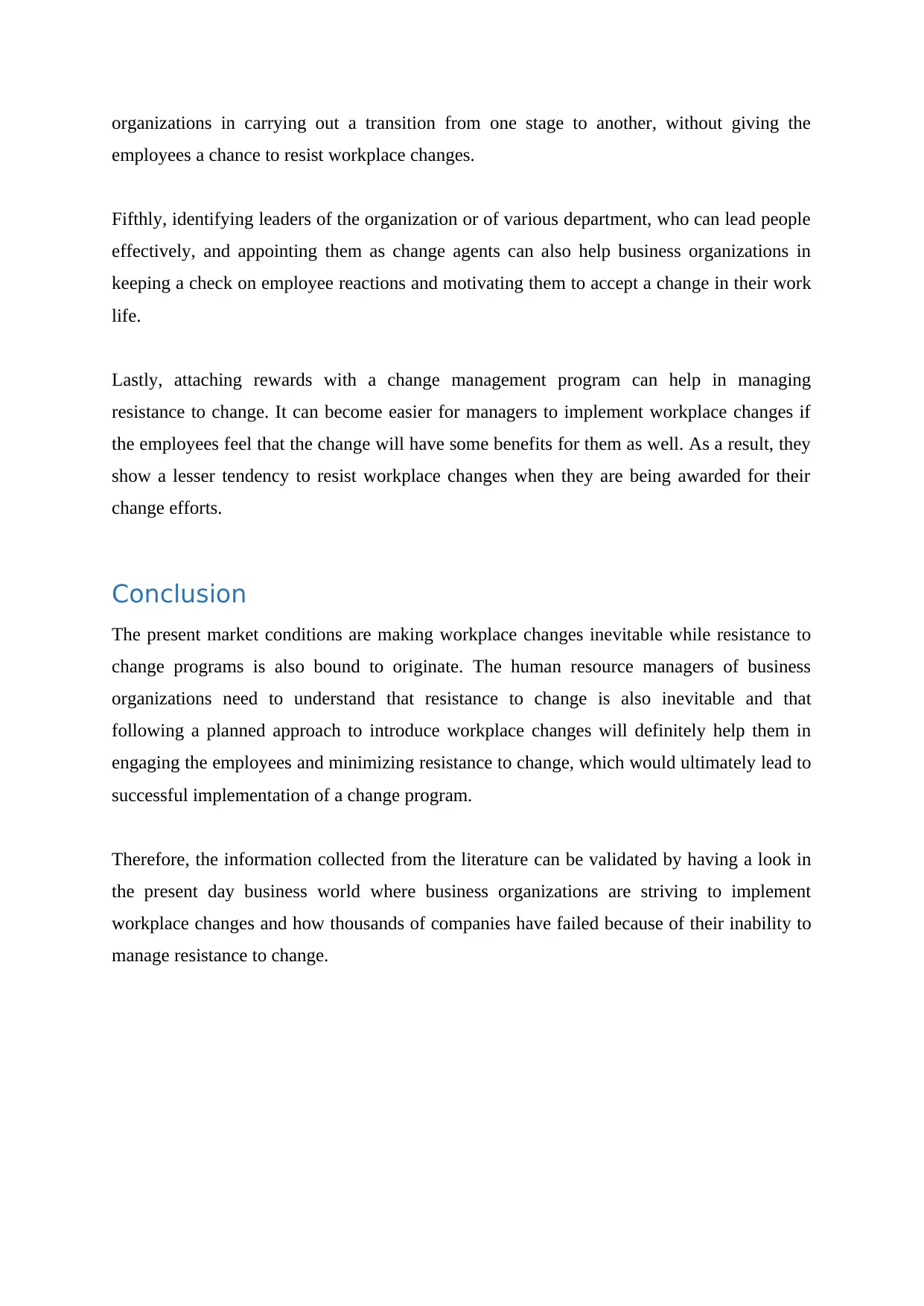
organizations in carrying out a transition from one stage to another, without giving the
employees a chance to resist workplace changes.
Fifthly, identifying leaders of the organization or of various department, who can lead people
effectively, and appointing them as change agents can also help business organizations in
keeping a check on employee reactions and motivating them to accept a change in their work
life.
Lastly, attaching rewards with a change management program can help in managing
resistance to change. It can become easier for managers to implement workplace changes if
the employees feel that the change will have some benefits for them as well. As a result, they
show a lesser tendency to resist workplace changes when they are being awarded for their
change efforts.
Conclusion
The present market conditions are making workplace changes inevitable while resistance to
change programs is also bound to originate. The human resource managers of business
organizations need to understand that resistance to change is also inevitable and that
following a planned approach to introduce workplace changes will definitely help them in
engaging the employees and minimizing resistance to change, which would ultimately lead to
successful implementation of a change program.
Therefore, the information collected from the literature can be validated by having a look in
the present day business world where business organizations are striving to implement
workplace changes and how thousands of companies have failed because of their inability to
manage resistance to change.
employees a chance to resist workplace changes.
Fifthly, identifying leaders of the organization or of various department, who can lead people
effectively, and appointing them as change agents can also help business organizations in
keeping a check on employee reactions and motivating them to accept a change in their work
life.
Lastly, attaching rewards with a change management program can help in managing
resistance to change. It can become easier for managers to implement workplace changes if
the employees feel that the change will have some benefits for them as well. As a result, they
show a lesser tendency to resist workplace changes when they are being awarded for their
change efforts.
Conclusion
The present market conditions are making workplace changes inevitable while resistance to
change programs is also bound to originate. The human resource managers of business
organizations need to understand that resistance to change is also inevitable and that
following a planned approach to introduce workplace changes will definitely help them in
engaging the employees and minimizing resistance to change, which would ultimately lead to
successful implementation of a change program.
Therefore, the information collected from the literature can be validated by having a look in
the present day business world where business organizations are striving to implement
workplace changes and how thousands of companies have failed because of their inability to
manage resistance to change.
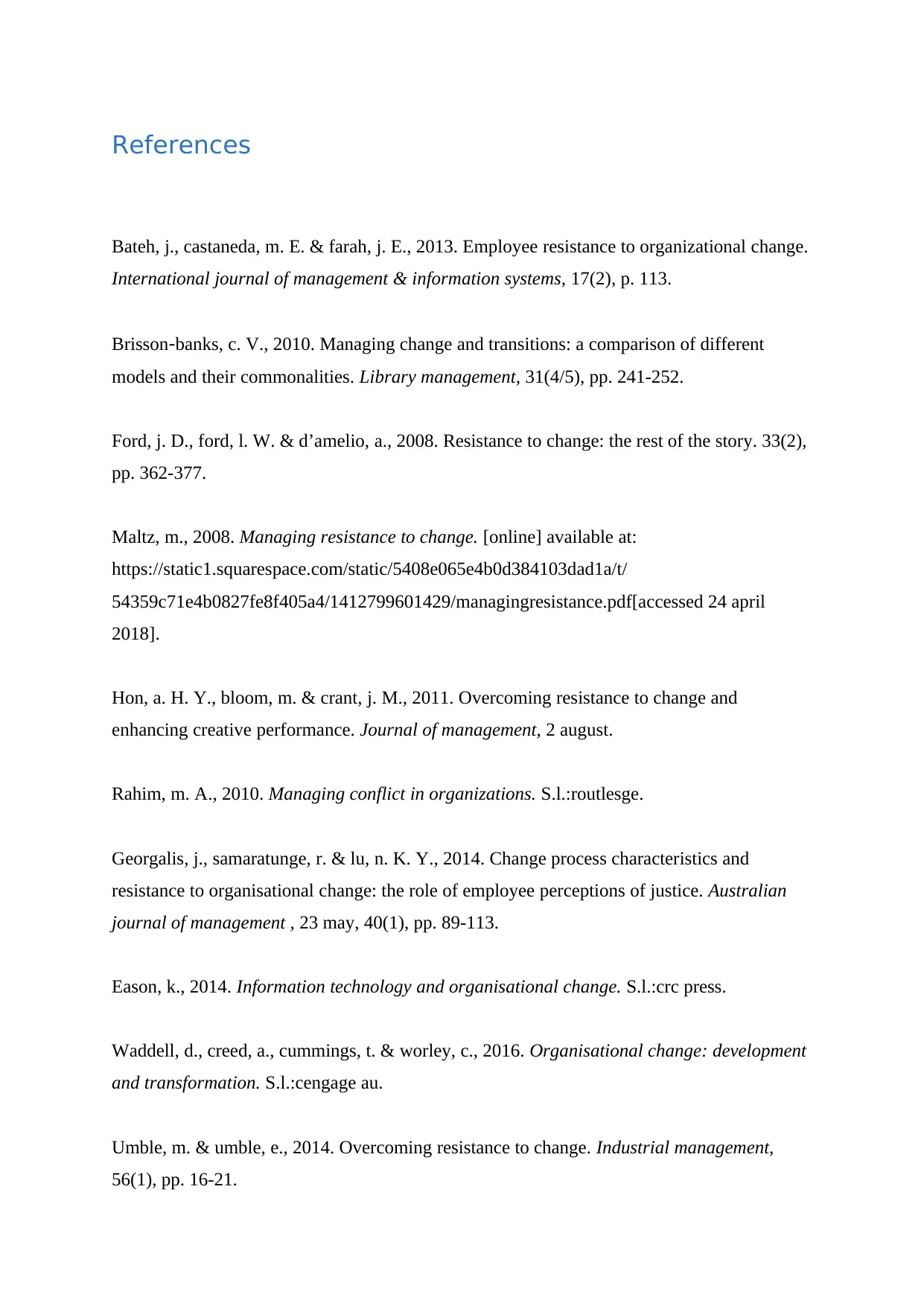
References
Bateh, j., castaneda, m. E. & farah, j. E., 2013. Employee resistance to organizational change.
International journal of management & information systems, 17(2), p. 113.
Brisson‐banks, c. V., 2010. Managing change and transitions: a comparison of different
models and their commonalities. Library management, 31(4/5), pp. 241-252.
Ford, j. D., ford, l. W. & d’amelio, a., 2008. Resistance to change: the rest of the story. 33(2),
pp. 362-377.
Maltz, m., 2008. Managing resistance to change. [online] available at:
https://static1.squarespace.com/static/5408e065e4b0d384103dad1a/t/
54359c71e4b0827fe8f405a4/1412799601429/managingresistance.pdf[accessed 24 april
2018].
Hon, a. H. Y., bloom, m. & crant, j. M., 2011. Overcoming resistance to change and
enhancing creative performance. Journal of management, 2 august.
Rahim, m. A., 2010. Managing conflict in organizations. S.l.:routlesge.
Georgalis, j., samaratunge, r. & lu, n. K. Y., 2014. Change process characteristics and
resistance to organisational change: the role of employee perceptions of justice. Australian
journal of management , 23 may, 40(1), pp. 89-113.
Eason, k., 2014. Information technology and organisational change. S.l.:crc press.
Waddell, d., creed, a., cummings, t. & worley, c., 2016. Organisational change: development
and transformation. S.l.:cengage au.
Umble, m. & umble, e., 2014. Overcoming resistance to change. Industrial management,
56(1), pp. 16-21.
Bateh, j., castaneda, m. E. & farah, j. E., 2013. Employee resistance to organizational change.
International journal of management & information systems, 17(2), p. 113.
Brisson‐banks, c. V., 2010. Managing change and transitions: a comparison of different
models and their commonalities. Library management, 31(4/5), pp. 241-252.
Ford, j. D., ford, l. W. & d’amelio, a., 2008. Resistance to change: the rest of the story. 33(2),
pp. 362-377.
Maltz, m., 2008. Managing resistance to change. [online] available at:
https://static1.squarespace.com/static/5408e065e4b0d384103dad1a/t/
54359c71e4b0827fe8f405a4/1412799601429/managingresistance.pdf[accessed 24 april
2018].
Hon, a. H. Y., bloom, m. & crant, j. M., 2011. Overcoming resistance to change and
enhancing creative performance. Journal of management, 2 august.
Rahim, m. A., 2010. Managing conflict in organizations. S.l.:routlesge.
Georgalis, j., samaratunge, r. & lu, n. K. Y., 2014. Change process characteristics and
resistance to organisational change: the role of employee perceptions of justice. Australian
journal of management , 23 may, 40(1), pp. 89-113.
Eason, k., 2014. Information technology and organisational change. S.l.:crc press.
Waddell, d., creed, a., cummings, t. & worley, c., 2016. Organisational change: development
and transformation. S.l.:cengage au.
Umble, m. & umble, e., 2014. Overcoming resistance to change. Industrial management,
56(1), pp. 16-21.
⊘ This is a preview!⊘
Do you want full access?
Subscribe today to unlock all pages.

Trusted by 1+ million students worldwide

Health, c. & health, d., 2011. Overcoming resistance to change. School administrator, 68(3),
pp. 28-32.
Canning, j. & found, p. A., 2015. The effect of resistance in organizational change
programmes: a study of a lean transformation. International journal of quality and service
sciences, 7(2/3), pp. 274-295.
pp. 28-32.
Canning, j. & found, p. A., 2015. The effect of resistance in organizational change
programmes: a study of a lean transformation. International journal of quality and service
sciences, 7(2/3), pp. 274-295.
1 out of 10
Related Documents
Your All-in-One AI-Powered Toolkit for Academic Success.
+13062052269
info@desklib.com
Available 24*7 on WhatsApp / Email
![[object Object]](/_next/static/media/star-bottom.7253800d.svg)
Unlock your academic potential
Copyright © 2020–2025 A2Z Services. All Rights Reserved. Developed and managed by ZUCOL.




